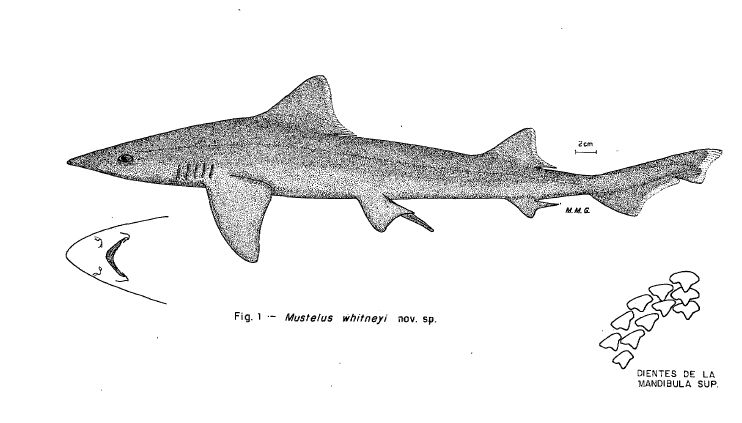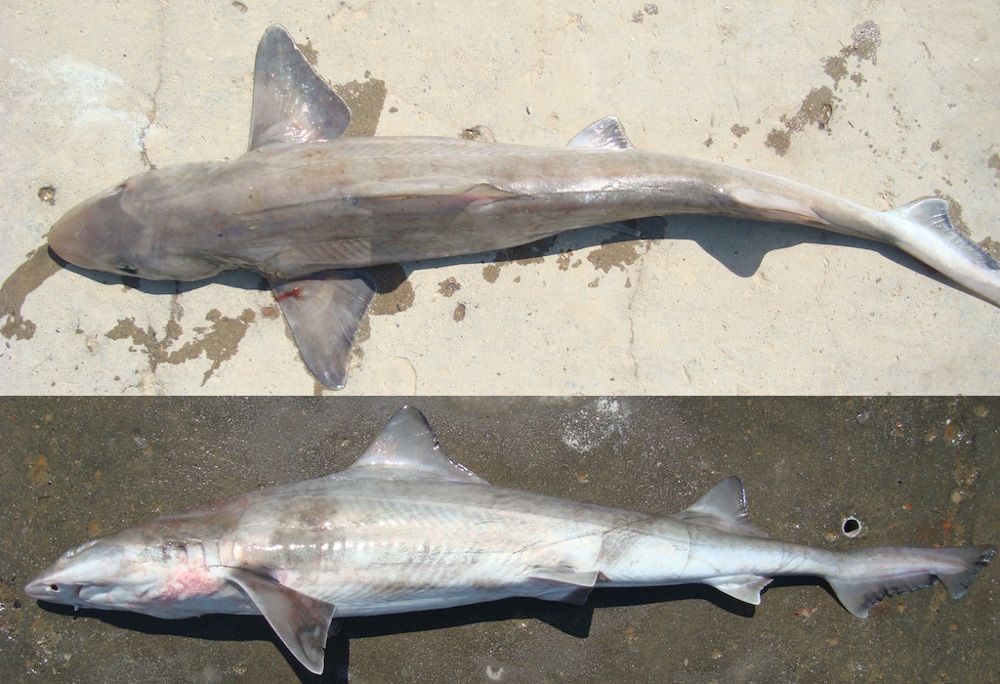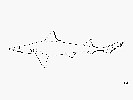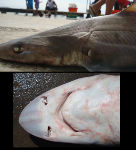Mustelus whitneyi
Chirichigno, 1973
Humpback smooth-hound
Classification: Elasmobranchii Carcharhiniformes Triakidae
Reference of the original description
Nuevas especies de peces de los generos Mustelus (Fam. Triakidae), Raja (Fam. Rajidae) y Schedophilus (Fam. Centrolophidae). Informes Especiales, Instituto del Mar del Perú, (42): 1–40
Nuevas especies de peces de los generos Mustelus (Fam. Triakidae), Raja (Fam. Rajidae) y Schedophilus (Fam. Centrolophidae). Informes Especiales, Instituto del Mar del Perú, (42): 1–40
Image of the original description

Mustelus whitneyi Chirichigno, 1973; In: Chirichigno, F.N. 1973 Nuevas especies de peces de los generos Mustelus (Fam. Triakidae), Raja (Fam. Rajidae) y Schedophilus (Fam. Centrolophidae). Informes Especiales, Instituto del Mar del Perú, (42): 1-40

Mustelus whitneyi Chirichigno, 1973; In: Chirichigno, F.N. 1973 Nuevas especies de peces de los generos Mustelus (Fam. Triakidae), Raja (Fam. Rajidae) y Schedophilus (Fam. Centrolophidae). Informes Especiales, Instituto del Mar del Perú, (42): 1-40
Types
Mustelus whitneyi
Holotype: IMARPE: 1210; Paratype: IMARPE: 10; IMARPE: 842; IMARPE: 1140; IMARPE: 1144; IMARPE: 1192; IMARPE: 1211;
Mustelus whitneyi
Holotype: IMARPE: 1210; Paratype: IMARPE: 10; IMARPE: 842; IMARPE: 1140; IMARPE: 1144; IMARPE: 1192; IMARPE: 1211;
Description :
Citation: Mustelus whitneyi Chirichigno, 1973: In: Database of modern sharks, rays and chimaeras, www.shark-references.com, World Wide Web electronic publication, Version 01/2026
Please send your images of "Mustelus whitneyi" to info@shark-references.com

Mustelus whitneyi Chirichigno, 1973, TL: 98 cm, female, Cancas, Tumbes, Peru © Adriana Gonzalez Pestana

Mustelus whitneyi Chirichigno, 1973, TL: 98 cm, female, Cancas, Tumbes, Peru © Adriana Gonzalez Pestana
Common names
 Musola prieta,
Musola prieta,  Piruche,
Piruche,  Tollo,
Tollo,  Tollo común,
Tollo común,  Tollo prieto,
Tollo prieto,  Emissole piruche,
Emissole piruche,  Humpback smooth hound,
Humpback smooth hound,  Humpback smooth-hound
Humpback smooth-hound
 Musola prieta,
Musola prieta,  Piruche,
Piruche,  Tollo,
Tollo,  Tollo común,
Tollo común,  Tollo prieto,
Tollo prieto,  Emissole piruche,
Emissole piruche,  Humpback smooth hound,
Humpback smooth hound,  Humpback smooth-hound
Humpback smooth-hound
Short Description
Diagnosis after Compagno, 1984 [517]: Body fairly stocky, almost humpbacked. Head fairly long, prepectoral length 20 to 24% of total length; snout moderately long and bluntly angular in lateral view, preoral snout 5.6 to 7.6% of total length, preorbital snout 6.7 to 8.5% of total length; internarial space very broad, 2.9 to 3.7% of total length; eyes fairly large, eye length .2 to 3.1 times in preorbital snout and 2.1 to 3.2% of total length; interorbital space moderately broad, 4.5 to 5.6% of total length; mouth moderately long, slightly longer than eye length and 2.6 to 3.7% of total length; upper labial furrows considerably longer than lowers and 2.6 to 3.7% of total length; teeth cuspidate and asymmetric, with a prominent primary cusp and low cusplets occasionally present; buccopharyngeal denticles confined to anterior fourth of palate and tongue tip. Interdorsal space 16 to 21% of total length; trailing edges of dorsal fins naked, with a conspicuous dark margin of bare ceratotrichia; first dorsal broadly triangular, with posteroventrally sloping posterior margin, midbase closer to pelvic bases than pectorals; pectoral fins fairly large, length of anterior margins 14 to 17% of total length, width of posterior margins 11 to 14% of total length; pelvic fins moderately large, length of anterior margins 7.1 to 9.4% of total length; anal fin height 2.3 to 3.8% of total length; anal-caudal space less than or subequal to second dorsal height, and 4.7 to 7.4% of total length; ventral caudal lobe hardly falcate in adults. Crowns of lateral trunk denticles lanceolate, with longitudinal ridges extending their entire length. Skeleton not hypercalcified in adults; palatine processes of palatoquadrates usually subdivided at symphysis, with a short separate medial segment on each side; monospondylous precaudal centra 36 to 41, diplospondylous precaudal centra 47 to 55, precaudal centra 86 to 93. Colour uniform grey or grey-brown above, lighter below, no white or dark spots or dark bars. Development viviparous. Size moderate, adults 68 to 87 cm.
Diagnosis after Compagno, 1984 [517]: Body fairly stocky, almost humpbacked. Head fairly long, prepectoral length 20 to 24% of total length; snout moderately long and bluntly angular in lateral view, preoral snout 5.6 to 7.6% of total length, preorbital snout 6.7 to 8.5% of total length; internarial space very broad, 2.9 to 3.7% of total length; eyes fairly large, eye length .2 to 3.1 times in preorbital snout and 2.1 to 3.2% of total length; interorbital space moderately broad, 4.5 to 5.6% of total length; mouth moderately long, slightly longer than eye length and 2.6 to 3.7% of total length; upper labial furrows considerably longer than lowers and 2.6 to 3.7% of total length; teeth cuspidate and asymmetric, with a prominent primary cusp and low cusplets occasionally present; buccopharyngeal denticles confined to anterior fourth of palate and tongue tip. Interdorsal space 16 to 21% of total length; trailing edges of dorsal fins naked, with a conspicuous dark margin of bare ceratotrichia; first dorsal broadly triangular, with posteroventrally sloping posterior margin, midbase closer to pelvic bases than pectorals; pectoral fins fairly large, length of anterior margins 14 to 17% of total length, width of posterior margins 11 to 14% of total length; pelvic fins moderately large, length of anterior margins 7.1 to 9.4% of total length; anal fin height 2.3 to 3.8% of total length; anal-caudal space less than or subequal to second dorsal height, and 4.7 to 7.4% of total length; ventral caudal lobe hardly falcate in adults. Crowns of lateral trunk denticles lanceolate, with longitudinal ridges extending their entire length. Skeleton not hypercalcified in adults; palatine processes of palatoquadrates usually subdivided at symphysis, with a short separate medial segment on each side; monospondylous precaudal centra 36 to 41, diplospondylous precaudal centra 47 to 55, precaudal centra 86 to 93. Colour uniform grey or grey-brown above, lighter below, no white or dark spots or dark bars. Development viviparous. Size moderate, adults 68 to 87 cm.
Human uses
fisheries: highly commercial; gamefish: yes; price category: medium; price reliability: questionable: based on ex-vessel price for species in this genus
fisheries: highly commercial; gamefish: yes; price category: medium; price reliability: questionable: based on ex-vessel price for species in this genus
Biology
Viviparous [517]. Distinct pairing with embrace [17086]. Fairly common. Occurs at 17-360 m depth, temperature range 12.88-16.20 °C (Ref. 9097 and 9098). An offshore bottom-dwelling shark found on the continental shelf. Prefers rocky bottom around islands. Feeds on crabs, mantis shrimp, and small bony fishes.
Viviparous [517]. Distinct pairing with embrace [17086]. Fairly common. Occurs at 17-360 m depth, temperature range 12.88-16.20 °C (Ref. 9097 and 9098). An offshore bottom-dwelling shark found on the continental shelf. Prefers rocky bottom around islands. Feeds on crabs, mantis shrimp, and small bony fishes.
Size / Weight / Age
87 cm TL (female)
87 cm TL (female)
Remarks
shark-references Species-ID=3830;
shark-references Species-ID=3830;
Parasites (arranged by Jürgen Pollerspöck)
Cestoda
Cestoda
- Orygmatobothrium musteli (Van Beneden, 1850) [25154]
- Scyphophyllidium triacis (Yamaguti, 1952) [25154]
- Symcallio lintoni (Euzet, 1954) [25154]


















